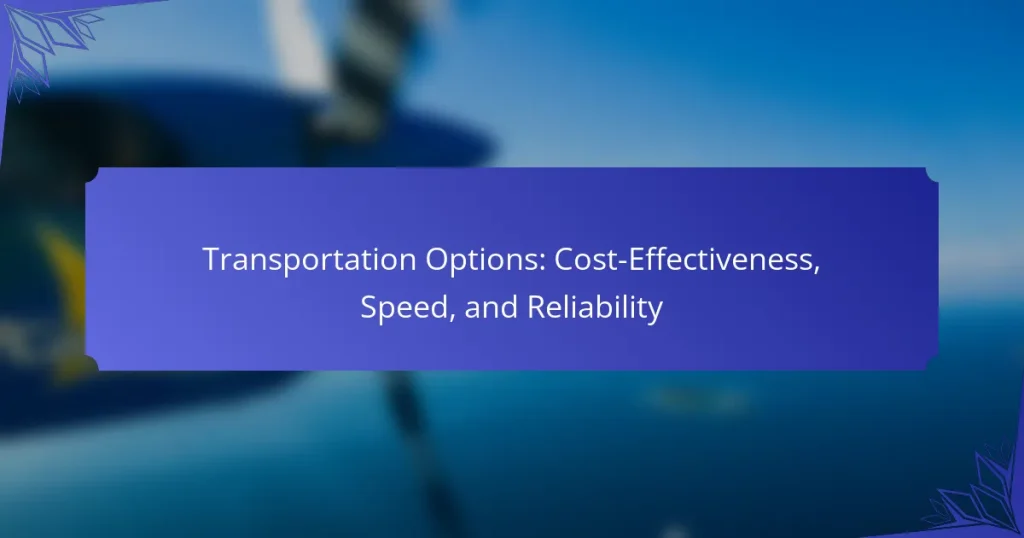When considering transportation options, it’s essential to evaluate cost-effectiveness, speed, and reliability. Public transit, bicycle sharing, and carpooling can minimize expenses, while air travel and high-speed rail excel in speed. Reliability is often best found in scheduled bus services and trains, which ensure consistent travel experiences.

What Are the Most Cost-Effective Transportation Options?
The most cost-effective transportation options include public transit systems, bicycle sharing programs, and carpooling services. These alternatives can significantly reduce travel expenses while offering varying levels of speed and reliability.
Public Transit Systems
Public transit systems, such as buses and trains, provide an economical way to travel within cities and regions. Fares typically range from a few dollars to around ten dollars per trip, depending on the distance and location.
When considering public transit, check for monthly passes that can lower costs for frequent travelers. Additionally, be aware of peak hours, as travel times may increase during busy periods.
Bicycle Sharing Programs
Bicycle sharing programs offer a low-cost and environmentally friendly transportation option. Users can rent bikes for short periods, often for less than a few dollars per hour or through affordable monthly subscriptions.
These programs are ideal for short trips and can help avoid traffic congestion. However, ensure to check the availability of bike stations and the condition of the bicycles before use.
Carpooling Services
Carpooling services connect drivers with passengers looking to share rides, making it a cost-effective choice for longer journeys. Costs are typically split among riders, making it cheaper than solo driving when considering fuel and tolls.
To maximize savings, use carpooling apps that facilitate matching with others heading in the same direction. Be mindful of scheduling and ensure that all participants agree on pick-up and drop-off locations to avoid complications.

How Do Transportation Options Compare in Speed?
Transportation options vary significantly in speed, impacting travel time and overall efficiency. Air travel generally offers the fastest long-distance option, while high-speed rail provides a quick alternative for shorter distances, and ride-sharing services can be efficient for local trips.
Air Travel
Air travel is the fastest mode for long distances, often covering hundreds of miles in just a few hours. For example, a flight from New York to Los Angeles can take around six hours, while the same journey by car could exceed 40 hours. However, consider additional time for airport security, boarding, and potential delays.
When booking flights, look for direct routes to minimize travel time. Also, be aware that peak travel seasons can lead to longer wait times and higher fares, so plan accordingly.
High-Speed Rail
High-speed rail systems, such as those in Europe and Asia, can reach speeds of up to 300 km/h (about 186 mph), making them an efficient choice for medium-distance travel. For instance, a train from Paris to London can take around two and a half hours, significantly less than driving or flying when considering total travel time.
These trains often offer frequent departures and less hassle than airports, but availability may vary by region. Always check schedules in advance, especially during holidays or weekends.
Ride-Sharing Services
Ride-sharing services like Uber or Lyft provide quick and convenient transportation for local trips, typically taking anywhere from a few minutes to half an hour, depending on traffic and distance. They are particularly useful in urban areas where public transport may be less accessible.
To optimize speed, request rides during off-peak hours and choose options like carpooling for lower costs, though this may increase wait times. Always check the estimated arrival time in the app before confirming your ride.

Which Transportation Options Are the Most Reliable?
The most reliable transportation options typically include scheduled bus services, trains, and long-distance coaches. Reliability is often measured by punctuality, frequency, and the likelihood of service interruptions.
Scheduled Bus Services
Scheduled bus services are designed to operate on fixed routes with predetermined stops and times. They can be very reliable, especially in urban areas where traffic patterns are well understood. However, delays can occur due to traffic congestion or road conditions.
To enhance reliability, check the bus company’s on-time performance records and consider using real-time tracking apps. Buses in cities often run every 15-30 minutes during peak hours, making them a dependable choice for short to medium distances.
Trains
Trains are generally one of the most reliable forms of transportation, particularly in regions with well-maintained rail infrastructure. They are less affected by road traffic and typically adhere to strict schedules. Many train services offer real-time updates on delays, which can help travelers plan accordingly.
In Europe, for example, trains often run on time over 90% of the time, making them a solid option for both short and long journeys. Consider booking tickets in advance to secure your seat and avoid last-minute issues.
Long-Distance Coaches
Long-distance coaches provide a cost-effective alternative for traveling between cities, but their reliability can vary. While many operators maintain good schedules, factors like road conditions and weather can impact travel times. It’s wise to check reviews and on-time statistics for specific services.
Coaches typically offer amenities like Wi-Fi and power outlets, making them a comfortable choice for longer trips. However, be prepared for potential delays, especially during peak travel seasons or holidays, when demand is high.

What Factors Affect Transportation Costs?
Transportation costs are influenced by several key factors, including fuel prices, maintenance expenses, and insurance rates. Understanding these elements can help individuals and businesses make informed decisions about their transportation options.
Fuel Prices
Fuel prices are a significant determinant of transportation costs, as they directly impact operational expenses. Fluctuations in global oil markets can lead to varying fuel prices, which can change weekly or even daily.
For example, a rise in fuel prices by just a few cents per liter can increase transportation costs by several percent, depending on the distance traveled and the vehicle’s fuel efficiency. It’s essential to monitor fuel prices regularly and consider alternative fuels or more efficient vehicles to mitigate these costs.
Maintenance Expenses
Maintenance expenses encompass the costs associated with keeping vehicles in good working condition, including routine servicing, repairs, and parts replacement. Regular maintenance can prevent costly breakdowns and extend the lifespan of vehicles.
On average, maintenance costs can range from a few hundred to several thousand dollars annually, depending on the type of vehicle and its usage. Businesses should establish a maintenance schedule and budget for these expenses to avoid unexpected costs.
Insurance Rates
Insurance rates are another crucial factor affecting transportation costs, as they vary based on the type of vehicle, usage, and the driver’s history. Higher coverage limits and additional policies can significantly increase premiums.
For instance, commercial vehicles may face higher insurance rates compared to personal vehicles due to increased risk factors. It’s advisable to shop around for insurance quotes and consider bundling policies to reduce overall costs.

How to Choose the Right Transportation Option?
Choosing the right transportation option involves evaluating factors such as distance, time, budget, and reliability. By understanding these elements, you can make an informed decision that best suits your needs.
Assessing Distance and Time
When assessing distance and time, consider how far you need to travel and the expected duration of the journey. For short distances, walking or cycling may be the quickest and most cost-effective options, while longer distances might necessitate public transport or driving.
Evaluate the average travel times for different modes of transportation. For instance, trains often provide faster travel for medium distances compared to buses, which may be subject to traffic delays. Use online tools or apps to compare estimated travel times for various options.
Evaluating Budget Constraints
Budget constraints play a crucial role in selecting a transportation option. Calculate the total cost of each option, including fares, fuel, parking, and any additional fees. For example, public transport may be cheaper than driving when considering fuel and parking costs.
Consider the trade-offs between cost and convenience. While a taxi may be more expensive than a bus, it could save you time and hassle, especially if you are in a hurry. Set a budget range and prioritize options that fit within it while meeting your time and reliability needs.


